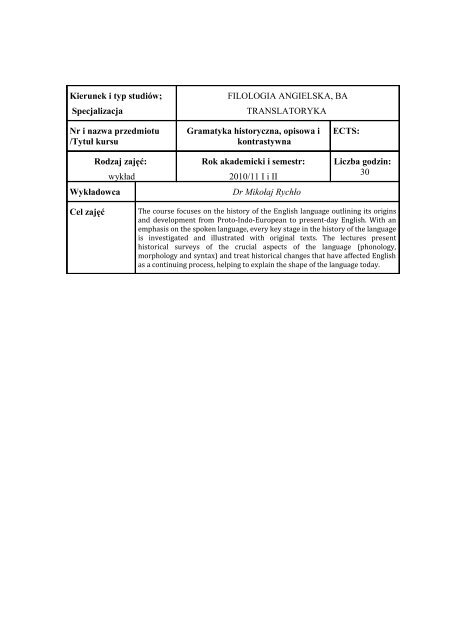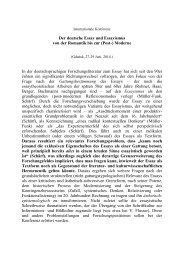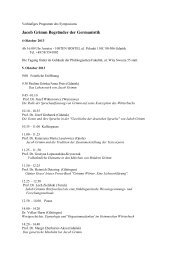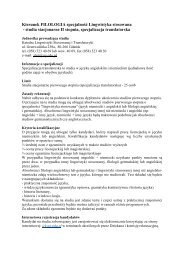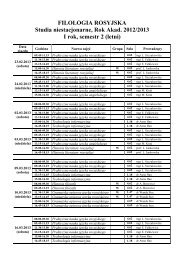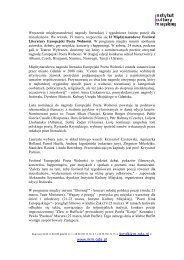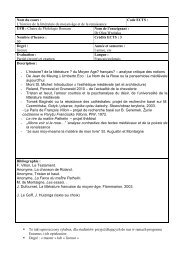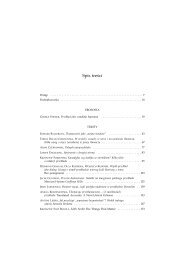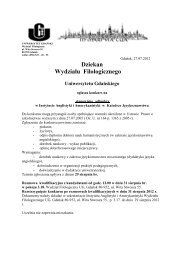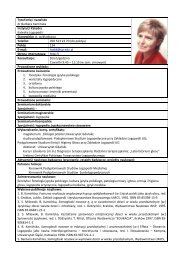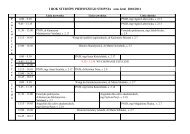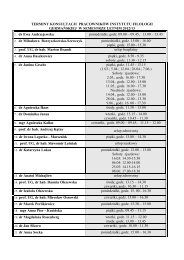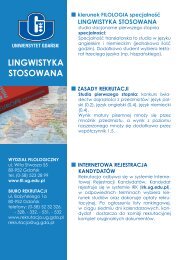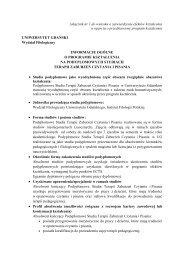I BA translatoryka
I BA translatoryka
I BA translatoryka
You also want an ePaper? Increase the reach of your titles
YUMPU automatically turns print PDFs into web optimized ePapers that Google loves.
Kierunek i typ studiów;<br />
Specjalizacja<br />
Nr i nazwa przedmiotu<br />
/Tytuł kursu<br />
Rodzaj zajęć:<br />
wykład<br />
FILOLOGIA ANGIELSKA, <strong>BA</strong><br />
TRANSLATORYKA<br />
Gramatyka historyczna, opisowa i<br />
kontrastywna<br />
Rok akademicki i semestr:<br />
2010/11 I i II<br />
Wykładowca Dr Mikołaj Rychło<br />
Cel zajęć<br />
ECTS:<br />
Liczba godzin:<br />
30<br />
The course focuses on the history of the English language outlining its origins<br />
and development from Proto-Indo-European to present-day English. With an<br />
emphasis on the spoken language, every key stage in the history of the language<br />
is investigated and illustrated with original texts. The lectures present<br />
historical surveys of the crucial aspects of the language (phonology,<br />
morphology and syntax) and treat historical changes that have affected English<br />
as a continuing process, helping to explain the shape of the language today.
Program zajęć 1. The Periods in the History of English<br />
2. The Great Vowel Shift (introduction)<br />
3. English as an Indo-European language<br />
4. The family tree of the Germanic branch within the Indo-European family<br />
5. From Proto-Indo-European to Proto-Germanic<br />
6. From Proto-Germanic<br />
to Old English<br />
a) Features of West Germanic<br />
b) the Anglo-Frisian period<br />
7. Linguistic features of the Germanic languages<br />
8. The earliest texts<br />
9. Early Old English sound changes<br />
a) i-umlaut<br />
b) palatalisation<br />
c) breaking<br />
10. An Introduction to Old English<br />
a) the four main dialects<br />
b) the system of pronouns<br />
c) the sounds and letters (general characteristics)<br />
d) the system of vowels<br />
e) the diphthongs (two hypotheses)<br />
f) the system of consonants<br />
i) anterior fricatives (voicedness)<br />
ii) geminates<br />
11. Old English as a synthetic language<br />
a) the nominal system of Old English and its later development (astem,<br />
o-stem, n-stem, irregular declensions)<br />
b) the verbal system of Old English and its later development (seven<br />
classes of strong verbs, three classes of weak verbs, conjugations)<br />
12. Historical sources of the present-day English irregular verbs<br />
13. Historical sources of the irregular plurals in modern English<br />
14. The main sources of foreign vocabulary in English.<br />
15. From Old English to Middle English<br />
a) orthographic innovations in ME<br />
b) regular vowel changes:<br />
c) homorganic lengthening<br />
d) pre-cluster shortening<br />
e) open syllable lengthening<br />
f) trisyllabic shortening<br />
16. The Great Vowel Shift<br />
a) the push-chain or the drag-chain?<br />
b) long vowels followed by liquids<br />
c) exceptions (great, yea, steak, break, drain)<br />
17. Consonant Changes in Early Modern English (cf. The General Prologue<br />
to the Canterbury Tales)<br />
18. Syntactic innovations of Early Modern English<br />
19. Differences between British and American English – preservations or<br />
innovations? (some indications of what EME was like)<br />
20. The etymological and phonological vicissitudes of selected words from<br />
texts listed in the requirements<br />
a) OE hlāf > PDE loaf<br />
b) OE ēac > ME eek > PDE eke (nickname)<br />
c) OE swā > PDE so (loss of /w/ before back vowels as in ME soote,<br />
swich, PDE two, answer, sword), etc.
Literatura<br />
Wymagania i<br />
forma<br />
zaliczenia:<br />
Algeo, John and Thomas Pyles. 2004 or earlier. The Origins and Development of the<br />
English Language. New York: Harcourt, Bruce &World.<br />
Baugh, Albert C. & Thomas Cable. 2002. A History of the English Language. London:<br />
Routledge.<br />
Brinton, Laurel J. and Leslie K. Arnovick. 2006. The English Language: a Linguistic<br />
History. Ontario: Oxford University Press.<br />
Fennell, Barbara A. 2001. A History of English. A Sociolinguistic Approach. Malden,<br />
Oxford: Blackwell Publishing.<br />
Hogg, Richard and David Denison (eds). 2008. A History of the English Language.<br />
Cambridge: Cambridge University Press.<br />
Lass, Roger. 1994. Old English: A historical linguistic companion. Cambridge: Cambridge<br />
University Press.<br />
Mitchell, Bruce and Fred C. Robinson. 2007. A Guide to Old English. Malden, Oxford:<br />
Blackwell Publishing.<br />
Mugglestone, Lynda (ed.).2008. The Oxford History of English. Oxford: Oxford University<br />
Press.<br />
There will be a written examination after the second semester covering the material<br />
from the lectures and home assignments.<br />
By the end of the course, the student will be expected to:<br />
1) be able to translate, pronounce and analyse grammatically the texts<br />
discussed during the lectures, stating for each word:<br />
- for nominal forms (nouns, adjectives, pronouns, numerals): case, number,<br />
gender and its nominative singular<br />
- for verbal forms: person, number, tense and mood; class and infinitive (when<br />
available)<br />
o The Lord’s Prayer (handout),<br />
o Texts 1-6, 8, 11, 12, 14 and 18 from Mitchell and Robinson (2007)<br />
o Beowulf (the first 25 lines),<br />
o Chaucer, Geoffrey. The Canterbury Tales. (the first 50 lines),<br />
o Shakespeare’s Sonnet 18 (“Shall I compare thee…”).<br />
2) be able to find examples of the sound-changes we discussed in class<br />
(Grimm’s Law, Verner’s Law, fronting, rounding, loss of nasal before fricative<br />
plus compensatory lengthening, i-mutation, breaking, palatalization, etc.),<br />
3) be able to find cognates,<br />
4) have read at least one history of English from the list above.
Kierunek i typ studiów;<br />
Specjalizacja<br />
Nr i nazwa<br />
przedmiotu /Tytuł<br />
kursu<br />
FILOLOGIA ANGIELSKA I <strong>BA</strong> stacjonarne<br />
Translatoryka/Translation Studies<br />
Historia literatury angielskiej/English<br />
Literary History<br />
Rodzaj zajęć: Rok akademicki i semestr:<br />
Wykładowca Prof. dr hab. Artur Blaim<br />
2011-2012 - semestr zimowy/ winter<br />
semestr<br />
ECTS:<br />
1<br />
Liczba godzin:<br />
30<br />
Cel zajęć Zajęcia mają na celu zapoznanie studentów z kluczowymi tekstami<br />
literatury angielskiej, ich usytuowaniu w kontekście<br />
historycznoliterackim i kulturze współczesnej, oraz podstawowymi<br />
metodami analizy tekstu.<br />
Program zajęć<br />
Students will study some of the key works from English medieval<br />
and Renaissance literature and their place in literary history and<br />
contemporary culture. They will also become acquainted with basic<br />
concepts and methods of literary analysis.<br />
1. Beowulf<br />
2. Geoffrey Chaucer – Canterbury Tales (selections)<br />
3. William Shakespeare – Henry IV<br />
4. William Shakespeare - Midsummer Night’s Dream<br />
5. William Shakespeare – The Merchant of Venice<br />
6. William Shakespeare – Hamlet<br />
7. William Shakespeare - King Lear<br />
8. William Shakespeare - The Tempest<br />
Dodatkowa lista filmów/Additional viewing list<br />
1. Pier Paolo Pasolini, dir. – Canterbury Tales<br />
2. Orson Welles, dir. – Falstaff<br />
3. Michael Hoffman, dir. – Midsummer Night’s Dream<br />
4. Grigori Kozintsev, dir. – King Lear<br />
5. Peter Brook, dir. – King Lear<br />
6. Akira Kurosawa, dir - Ran<br />
7. Peter Greenaway, dir. – Prospero’s Books
Literatura<br />
o Michael Alexander - A History of English Literature,<br />
London: Macmillan 2000.<br />
o Ronald Carter & John McRae, The Routledge History of<br />
Literature in English, London: Routledge 1997.<br />
o Andrzej Zgorzelski, Lectures on British Literature, Lublin:<br />
WSSP 2008.<br />
Harold Bloom, ed. Geoffrey Chaucer’s Canterbury Tales, New<br />
York: Bloom’s Literary Criticism, 2008<br />
Elsa Sjoberg, From Madcap Prince to King: The Evolution of<br />
Prince Hal, Shakespeare Quarterly XX (1961), 33-46.<br />
Hugh Dickinson, The Reformation of Prince Hal, Shakespeare<br />
Quarterly XII (1961), 33-46.<br />
Julia Reinhard Lupton, Creature Caliban, Shakespeare Quarterly<br />
Vol. 51 (2000), 1-23.<br />
Dean Ebner, The Tempest: Rebellion and the Ideal State,<br />
Shakespeare Quarterly, Vol. 16 (1965), 161-173<br />
James Calderwood, “Hamlet. The Name of Action,” Modern<br />
Language Quarterly Vol. 39 (1978), 331-362.<br />
William Dodd, Impossible Worlds: What Happens in King Lear,<br />
Act 1, Scene 1?, Shakespeare Quarterly, Vol. 50 (1999), 477-<br />
507.<br />
D.M. Cohen, The Jew and Shylock, Shakespeare Quarterly, Vol.<br />
31 (1980), 53-63.<br />
James L. Calderwood – Creative Uncreation in King Lear,<br />
Shakespeare Quarterly XXXVII (1986), 5-19.<br />
Fredson Bowers, The Structure of King Lear, Shakespeare<br />
Quarterly XXXI (1980), 7-20.<br />
Herbert Bronstein, Shakespeare, the Jews and The Merchant of<br />
Venice, Shakespeare Quarterly, XX (1969), 3-10.<br />
Phyllis Rackin, Delusion and Resolution in King Lear,<br />
Shakespeare Quarterly, XXI (1970), p. 29-34.
Wymagania i<br />
forma<br />
zaliczenia:<br />
Aktywne uczestnictwo w zajęciach. 2. Ustna prezentacja na<br />
zadany temat (1). 3. Egzamin – 10 otwartych pytań z<br />
złożony z 10 otwartych pytań dotyczący zagadnień<br />
omawianych na ćwiczeniach i samodzielnej lektury<br />
opracowań/1. Regular attendance and active participation<br />
in class activities 2. One oral presentation. 3. Take-home<br />
exam: ten open questions relating to discussions in class and<br />
reading list.
Kierunek i typ studiów;<br />
Specjalizacja<br />
Nr i nazwa<br />
przedmiotu /Tytuł<br />
kursu<br />
Rodzaj zajęć:<br />
Ćwiczenia<br />
Wykładowca Mgr Joanna Gilis-Siek<br />
FILOLOGIA ANGIELSKA – I <strong>BA</strong> stacjonarne<br />
Translatoryka<br />
Kurs zintegrowany/Integrated Skills ECTS:<br />
Rok akademicki i semestr:<br />
2011-2012 semestr zimowy/Winter<br />
semester<br />
Liczba godzin:<br />
Cel zajęć Celem kursu jest umożliwienie studentom zrównoważonego<br />
rozwoju umiejętności czytania i słuchania ze zrozumieniem oraz<br />
mówienia i pisania na poziomie C1.<br />
The aim of this course is to provide students with balanced practice<br />
in all the language skills, i.e. reading, listening, speaking and<br />
writing. The first two terms of the three-year <strong>BA</strong> course should<br />
bring students up to Level C1.<br />
Program zajęć Ćwiczenia<br />
In Sickness and in Health<br />
First Impressions<br />
Safety and Danger<br />
Stranger than Fiction<br />
It Broadens the Mind<br />
Art for Art’s Sake<br />
Only Flesh and Blood<br />
Words Speak Volumes<br />
Literatura Gude, K. and M. Duckworth (1994) Masterclass Proficiency. OUP<br />
Wymagania i<br />
forma<br />
zaliczenia:<br />
Regularne uczestnictwo w zajęciach + test semestralny<br />
sprawdzający umiejętność czytania, słuchania, pisania oraz<br />
słownictwa na poziomie C1 (format egzaminu CAE)<br />
Regular attendance + Final test testing the ability to read, listen and<br />
write at Level C1 (CAE examination format)<br />
30
Kierunek i typ studiów;<br />
Specjalizacja<br />
Nr i nazwa<br />
przedmiotu /Tytuł<br />
kursu<br />
Rodzaj zajęć:<br />
ćwiczenia<br />
FILOLOGIA ANGIELSKA<br />
specjalizacja translatoryczna<br />
Tłumaczenia ogólne ECTS: 4<br />
Rok akademicki i semestr:<br />
2011/2012, semestr I<br />
Wykładowca mgr Justyna Trojnar<br />
Cel zajęć<br />
Liczba godzin:<br />
30<br />
Kurs przekładu ogólnego stanowi wprowadzenie do kolejno proponowanych w<br />
ramach studiów kursów z przekładu tekstów humanistycznych i<br />
specjalistycznych. Ma na celu zapoznanie studentów z narzędziami dostępnymi w<br />
pracy tłumacza oraz specyfiką procesu tłumaczenia. Materiałem kursowym jest<br />
wybór autentycznych tekstów o znacznym zróżnicowaniu stylistycznym,<br />
napisanych głównie w języku angielskim, ale również w polskim.<br />
Wyselekcjonowane teksty mają za zadanie uświadomić studentom różnice<br />
rejestrów (język przewodników turystycznych, tekstów prasowych,<br />
popularnonaukowych, poradników oraz artykułów poświęconych architekturze), a<br />
jednocześnie nauczyć przekładu idiomatycznej angielszczyzny na idiomatyczną<br />
polszczyznę. Kurs obejmuje ponadto materiał z interpunkcji polskiej i angielskiej<br />
(UK) oraz polskiej fleksji, ze szczególnym uwzględnieniem odmiany imion<br />
własnych.
Program zajęć<br />
Wprowadzenie oraz teksty humorystyczne (1)<br />
• omówienie programu zajęć, wymagań i bibliografii<br />
• przegląd stron internetowych wartych uwagi<br />
• przekład krótkiego tekstu humorystycznego<br />
• omówienie problemów translatorskich, zastanowienie się nad zaletami i wadami<br />
zaproponowanych rozwiązań<br />
• wierność a adaptacja (wprowadzenie pojęć ‘domestication’ i ‘foreignisation’)<br />
Teksty humorystyczne (2)<br />
• omówienie nadesłanych przekładów tekstu humorystycznego (problemy, zalety i wady<br />
zaproponowanych rozwiązań)<br />
• przyjrzenie się etapom pracy tłumacza<br />
Język przewodników (1)<br />
Język przewodników (2)<br />
• wprowadzenie (prezentacja fragmentów przewodników napisanych w języku polskim,<br />
cechy języka)<br />
• przekład a jego odbiorca<br />
• tłumaczenie i odmiana nazw własnych<br />
• unikanie powtórzeń i zbędnych zaimków<br />
• omówienie przekładów wykonanych poza zajęciami (problemy, zalety i wady<br />
zaproponowanych rozwiązań)<br />
• wykonanie i omówienie krótkich ćwiczeń interpunkcyjnych i fleksyjnych<br />
Język artykułów prasowych (1)<br />
Język artykułów prasowych (2)<br />
Język artykułów prasowych (3)<br />
• wprowadzenie (nagłówki w języku polskim i angielskim, fragmenty artykułów<br />
napisanych w języku polskim, cechy języka prasowego)<br />
• zapis wypowiedzi, dialogów (konwencje w języku polskim i angielskim)<br />
• problemy związane z nadużywaniem strony biernej i imiesłowów przysłówkowych w<br />
języku polskim<br />
• różnicowanie rejestru (tłumaczenie na zajęciach fragmentów artykułów z dzienników i<br />
prasy brukowej)<br />
• redakcja przekładów przygotowanych w czasie zajęć<br />
• omówienie przekładów wykonanych poza zajęciami (problemy, zalety i wady<br />
zaproponowanych rozwiązań, wybór najciekawszych nagłówków zaproponowanych<br />
przez studentów<br />
• różnice kulturowe i ich znaczenie w dziedzinie przekładu<br />
• wykonanie i omówienie krótkich ćwiczeń interpunkcyjnych i fleksyjnych<br />
Omówienie tłumaczenia na ocenę z komentarzem<br />
9. wspólne omówienie tekstu oraz tłumaczeń na ocenę przygotowanych poza zajęciami<br />
(problemy, lepsze i gorsze rozwiązania oraz błędy)<br />
Test z fleksji i interpunkcji<br />
o test sprawdzający znajomość interpunkcji (polskiej i angielskiej) oraz polskiej fleksji<br />
(ze szczególnym uwzględnieniem nazw własnych)<br />
Teksty popularnonaukowe<br />
Poradniki<br />
• omówienie cech języka (precyzja, jednoznaczność, logiczna kompozycja)<br />
• problem powtórzeń<br />
• tłumaczenie pojęć<br />
• omówienie przekładów wykonanych poza zajęciami (problemy, zalety i wady<br />
zaproponowanych rozwiązań)<br />
• omówienie tekstu z fleksji i interpunkcji<br />
Wywiady (1)<br />
Wywiady (2)<br />
• wywiad jako tekst<br />
• tłumaczenie wywiadu z języka angielskiego na język polski oraz z języka polskiego na<br />
język angielski<br />
• omówienie przekładów wykonanych poza zajęciami (problemy, zalety i wady<br />
zaproponowanych rozwiązań)<br />
• konfrontacja obrazu wyłaniającego się z tekstu z obrazem na ekranie<br />
Tłumaczenie na ocenę<br />
II. dokonanie samodzielnego przekładu w czasie zajęć<br />
Podsumowanie<br />
III. omówienie tłumaczenia na zajęciach<br />
IV. indywidualna rozmowa z każdym uczestnikiem kursu na temat zdobytych<br />
umiejętności, mocnych i słabszych stron, możliwości rozwoju
Literatura<br />
Wymagania i<br />
forma<br />
zaliczenia:<br />
Belczyk, Arkadiusz. 2009. Poradnik tłumacza. Kraków: Wydawnictwo<br />
IDEA.<br />
Dutka, Wojciech, Beata Gajewska, Anna Willman. 2002. Słownik<br />
ortograficzny z zasadami gramatycznymi. Bielsko-Biała: PPU Park.<br />
Herman, Wilga. 2003. Interpunkcja i składnia: poradnik dla tych którzy<br />
pierwszy raz... Warszawa: Oficyna Edukacyjna Krzysztof Pazdro.<br />
Korzeniowska, Aniela, Piotr Kuhiwczak. 2006. Successful Polish-English<br />
Translation. Tricks of the Trade. Wydanie III. Warszawa: Wydawnictwo<br />
Naukowe PWN.<br />
Mosiołek-Kłosińska, Katarzyna (red.). 2001. Formy i normy, czyli<br />
poprawna polszczyzna w praktyce: praca zbiorowa. Warszawa:<br />
Wydawnictwo Felberg SJA.<br />
Podracki, Jerzy. 1993. Słownik interpunkcyjny języka polskiego.<br />
Warszawa: Wydawnictwo Oświata.<br />
Wymagania na zaliczenie<br />
terminowe nadesłanie wszystkich zadanych przekładów<br />
obecność na zajęciach (uczestnik kursu może opuścić maksymalnie 2<br />
spotkania)<br />
ocena końcowa min. 51%<br />
Ewaluacja postępów uczestnika kursu<br />
tłumaczenie z komentarzem przygotowane poza zajęciami (30% oceny<br />
końcowej)<br />
test z fleksji i interpunkcji (30% oceny końcowej)<br />
tłumaczenie na zajęciach (40% oceny końcowej)<br />
Dodatkowo pod uwagę brane będą:<br />
aktywne uczestnictwo w zajęciach;<br />
przygotowanie krótkiej prezentacji dotyczącej aktualnie omawianych<br />
tekstów.
Kierunek i typ studiów;<br />
Specjalizacja<br />
Nr i nazwa<br />
przedmiotu /Tytuł<br />
kursu<br />
FILOLOGIA ANGIELSKA <strong>BA</strong> stacjonarne i zaoczne<br />
Phonetics I / Fonetyka j.angielskiego I<br />
<strong>BA</strong> stacjonarne i zaoczne<br />
Rodzaj zajęć: Rok akademicki I semestr:<br />
Wykładowca Dr Ewa Kremky<br />
2011/2012 – semestr zimowy / winter<br />
semester<br />
ECTS:<br />
Liczba godzin:<br />
30<br />
Cel zajęć Opanowanie samogłoskowego systemu fonologicznego<br />
j.angielskiego(RP), umiejętność ˝linking˝, stosowania<br />
˝słabych/mocnych˝form tzw. ˝function words˝ w mowie wiązanej<br />
oraz podstaw transkrypcji fonemicznej.<br />
Program zajęć<br />
The course is focused on the individual segments of RP vowels,<br />
their characteristics and then their simplifications in connected<br />
speech, and on the basics of phonemic transcription.<br />
o Qualitative and quantitative vowel differences<br />
o Front, central and back vowels. High / mid / low vowels<br />
o Tense / lax vowels. Rounded vowels<br />
o Stress-timing in English<br />
o The reduced vowel ˝schwa˝<br />
o Diphthongs<br />
o Triphthongs (˝smoothing˝)<br />
o Linking. Sandhi – r<br />
o Strong / weak forms<br />
o Pre-fortis vowel clipping<br />
o Word –stress in English<br />
o Basics of phonemic transcription<br />
o Reading transcribed passages.<br />
o Listening to different varieties of English.<br />
o Summing up.<br />
Literatura Ponsonby, M. (1995) How now, Brown Cow? A course in the<br />
pronunciation of English. Cambridge: CUP.<br />
Collins, B. and Mees (2003) Practical Phonetics and Phonology. A<br />
resource book for students. Routledge.<br />
Underhill, A. (2003) Sound Foundations. Learning and teaching<br />
pronunciation. Macmillan.<br />
Wells, J.C. (2009) Longman Pronunciation Dictionary. Harlow:<br />
Pearson.
Wymagania i<br />
forma<br />
zaliczenia:<br />
Obowiązkowa obecność na zajęciach ( można mieć dwie<br />
nieusprawiedliwione nieobecności w semestrze) pozwala na<br />
bieżąco monitorować przygotowanie, prace własną i progres<br />
każdego studenta. Ocenie tej służą także dyktanda fonetyczne<br />
sprawdzające umiejętność dyskryminacji i identyfikacji fonemicznej<br />
i fonetycznej.<br />
These classes are compulsory and attendance at these will be<br />
carefully monitored (a student may miss two classes with no<br />
evidence required for the absences to be condoned).<br />
The course is assessed 100% by coursework.<br />
Nazwa przedmiotu:<br />
Praktyczna nauka języka angielskiego<br />
Kod ECTS<br />
Nazwa jednostki prowadzącej<br />
kierunek:<br />
Nazwa kierunku: <strong>BA</strong>-T<br />
Instytut Anglistyki<br />
Hasło do e-learningu: pnja-kz-IA-<strong>BA</strong>-T-HK<br />
Zakład dydaktyki języka angielskiego<br />
Nazwa specjalności:<br />
Nazwisko osoby prowadzącej (osób prowadzących): mgr Hanna Kryszewska<br />
Liczba godzin zajęć, w tym:<br />
wykładów, ćwiczeń, konwersatoriów,<br />
laboratoriów, seminariów: ćwiczenia<br />
30<br />
Rodzaj studiów (stacjonarne,<br />
niestacjonarne, I, II stopnia):<br />
stacjonarne I stopnia<br />
Status przedmiotu (obligatoryjny,<br />
fakultatywny): obligatoryjny<br />
Metody dydaktyczne:<br />
1 metoda komunikatywna<br />
2 praca w grupach, praca w parach,<br />
3 praca nad rozumieniem tekstu<br />
pisanego<br />
i mówionego<br />
4 praca nad płynnością i<br />
poprawnością w<br />
mówieniu<br />
5 e-learning<br />
Liczba punktów ECTS:<br />
Rok i semestr studiów:<br />
rok 3, semestr 5<br />
Język wykładowy: angielski<br />
Formy zaliczania przedmiotu:<br />
zaliczenie NA OCENĘ<br />
Warunki zaliczania w formule ‘continuous<br />
assessment’:<br />
1 aktywność na zajęciach, przygotowanie i elearning<br />
20p<br />
2 czytanie 2 testy - 20 p<br />
3 słuchanie 2 testy - 20 p<br />
4 mówienie 2 testy 20 p<br />
5 słownictwo 20 p
Max 100 p – zaliczenie 51 p<br />
91-100 grade 5<br />
90-81 grade 4+<br />
80-71 grade 4<br />
70-61 grade 3+<br />
60-51 grade 3<br />
Wymagana obecność na zajęciach – max 2<br />
nieobecności<br />
Określenie przedmiotów wprowadzających wraz z wymogami wstępnymi:<br />
Znajomość języka angielskiego na poziomie C1 (zaawansowanym)<br />
Założenia i cele przedmiotu:<br />
Doskonalenie umiejętności czytania, słuchania i mówienia.<br />
Praca nad poprawnością językową i płynnością.<br />
Poszerzanie pasywnej i aktywnej znajomości słownictwa.<br />
Treści programowe:<br />
1 Introduction to the course. Group formation.<br />
2 Fine arts<br />
3 Politics and manipulation<br />
4 Family in history<br />
5 Global issues<br />
5 Work<br />
6 Gender<br />
7 Science<br />
8 Academia<br />
9. Language<br />
10. Culture/Christmas<br />
11.Natural World<br />
12. Reading and listening for gist, detail, grammar and lexis. Activation and use of a<br />
variety of lexical items and grammar structures in speaking.<br />
Wykaz literatury podstawowej i uzupełniającej:<br />
1 New Proficiency Testbuilder, Mark Harrison, Macmillan2002<br />
2 Grammar and Vocabulary from Cambridge Advanced and Proficiency, R. Side and<br />
Guy Wellman, Cambridge1999<br />
3 Materiały autentyczne<br />
Umiejętności i kompetencje:<br />
Student będzie potrafił wysłowić się na poziomie zaawansowanym C2, potrafi<br />
zrozumieć tekst pisany i mówiony na poziomie C2 oraz trudne teksty autentyczne<br />
Będzie w stanie studiować w języku angielskim i bardzo swobodnie się w nim<br />
porozumiewać<br />
Kontakt:<br />
brchk@univ.gda.pl
Kierunek i typ studiów: I<br />
<strong>BA</strong> studia stacjonarne<br />
Specjalizacja:<br />
Translatoryka<br />
Nr i nazwa przedmiotu<br />
/Tytuł kursu<br />
Rodzaj zajęć:<br />
ćwiczenia<br />
Wykładowca dr Monika<br />
Szuba<br />
FILOLOGIA ANGIELSKA<br />
Historia literatury brytyjskiejECTS:<br />
Rok akademicki i semestr:<br />
2011/2012 semestr zimowy<br />
Cel zajęć Celem zajęć jest przybliżenie studentom<br />
wybranych dzieł literatury angielskiej od okresu<br />
średniowiecza do renesansu. Efekt kształcenia:<br />
rozwinięcie umiejętności analizy i interpretacji<br />
tekstów z uwzględnieniem kontekstu<br />
literackiego, historycznego i kulturowego.<br />
Program zajęć “The Wanderer”, “ The Seafarer”<br />
Beowulf<br />
Geoffrey Chaucer, The Canterbury Tales,<br />
“General Prologue,” “The Miller’s Tale”<br />
Sir Gawain and the Green Knight<br />
Edmund Spenser, The Faerie Queene, Book I,<br />
Canto i, 1-27<br />
John Milton, Paradise Lost, Book I<br />
Alexander Pope, The Rape of the Lock, Canto 1<br />
John Donne, “To His Mistress Going to Bed”<br />
(Elegy 19), “The Good Morrow,” “The Sun<br />
Rising,” “The Flea”<br />
George Herbert, “Easter Wings,” “The Church-<br />
Floor,” “The Collar,” “Prayer (I)”<br />
Andrew Marvell, “To His Coy Mistress,” “An<br />
Horatian Ode”<br />
Liczba<br />
godzin:<br />
30
Literatura<br />
Wymagania i forma<br />
zaliczenia:<br />
Ben Jonson, “To Penshurst”<br />
John Milton, “Lycidas”<br />
Christopher Marlowe, Doctor Faustus<br />
William Shakespeare, King Lear<br />
John Webster, The Duchess of Malfi<br />
D. Daiches, A Critical History of English<br />
Literature, London: Secker and Warburg, 1975.<br />
R. Carter, J. McRae. The Routledge History of<br />
Literature in English: Britain and Ireland,<br />
London: Routledge, 1997.<br />
P. Poplawski. English Literature in Context,<br />
Cambridge: Cambridge UP 2008.<br />
S. Greenblatt (ed.). The Norton anthology of<br />
English literature. New York-London: W.W.<br />
Norton & Company, 2006.<br />
A. Baugh (ed.). 1980. A Literary History of<br />
England. London: Routledge-Kegan & Paul.<br />
Zaliczenie kursu oraz końcowa ocena oparte będą<br />
o aktywne uczestniczenie w zajęciach oraz<br />
zaliczenie ustnego testu semestralnego.
Kierunek i typ studiów;<br />
Specjalizacja<br />
Nr i nazwa<br />
przedmiotu /Tytuł<br />
kursu<br />
Rodzaj zajęć:<br />
Cwiczenia/ classes<br />
Filologia Angielska, I <strong>BA</strong> stacjonarne<br />
Gramatyka Praktyczna/Practical<br />
Grammar<br />
Rok akademicki i semestr:<br />
2011/2012 semestr zimowy i letni<br />
Wykładowca Mgr Renata Zander-Lewandowska<br />
Cel zajęć<br />
Program zajęć<br />
ECTS:<br />
Liczba godzin:<br />
60<br />
Celem kursu jest zapoznanie studentów ze wszystkimi aspektami<br />
gramatyki języka angielskiego w zastosowaniu praktycznym (na<br />
poziomie zaawansowanym)<br />
The aim of this course is to provide students with the complete<br />
knowledge of English grammar in practical use (advanced level)<br />
Rok I, semestr 1 i 2<br />
YEAR I: Terms 1 and 2<br />
TERM 1<br />
1. Elements of grammar<br />
2. Tenses and the subjunctive<br />
3. Modal verbs<br />
4. Conditional sentences<br />
5. The passive voice<br />
TERM 2<br />
6. Nouns<br />
7. Gerund and infinitive; participles and participial clauses<br />
8. Articles<br />
9. Clauses<br />
10. Ways of expressing emphasis<br />
Students’ self-study<br />
11. Miscellaneous: Irregular verbs. Verbs often confused: lie/lay,<br />
sew/saw/sow, rise/raise etc. /Phrasal verbs. /Prepositions. /Question tags. /<br />
Pronouns. / Determiners. / Quantifiers (much, many, a great deal, etc.). /<br />
Comparatives and superlatives. / “It” vs. “There” as preparatory subjects. /<br />
Reported Speech
Literatura<br />
Wymagania i<br />
forma<br />
zaliczenia:<br />
Practical Grammar Year I Booklist:<br />
o Vince, M. (3 rd edition,2009). Advanced Language Practice.<br />
Macmillan.<br />
o Hewings, M. (2 nd edition, 2003) Advanced Grammar in<br />
Use. CUP.<br />
o Foley, M. & D. Hall (2003) Advanced Learners’ Grammar.<br />
Longman.<br />
o Gethin, H. (1992) Grammar in Context. Nelson.<br />
o Carter, R., R. Hughes and M.MacCarthy (2000) Exploring<br />
Grammar in Context. CUP.<br />
o Mann, M. and S. Taylor-Knowles (2008) Destination<br />
C1&C2 Grammar and Vocabulary, Macmillan.<br />
o Side, R. and G. Wellman (1999). Grammar and Vocabulary<br />
for Cambridge Advanced and Proficiency. Longman.<br />
o Graver, B.D. (1986) Advanced English Practice. OUP.<br />
o Swan, M. (1995). Practical English Usage. 2 nd ed. OUP.<br />
o Thomson, A.J. and A.V. Martinet (1986) A Practical<br />
English Grammar. OUP.<br />
W trakcie roku przewidziane są 4 testy (po 2 na semestr). Aby<br />
otrzymać zaliczenie z przedmiotu student musi uzyskać średnią 51%<br />
z 4 testów.<br />
Obecność na zajęciach jest wymagana.<br />
During the year there will be 4 tests. To pass the course the student<br />
will have to get the average of 51% from 4 tests.<br />
Presence is obligatory.
Kierunek i typ studiów;<br />
Specjalizacja<br />
Nr i nazwa<br />
przedmiotu /Tytuł<br />
kursu<br />
Rodzaj zajęć:<br />
Lecture<br />
FILOLOGIA ANGIELSKA<br />
Year 1 <strong>BA</strong>-N / <strong>BA</strong>-T<br />
DEscriptive Grammar: Phonetics and<br />
Phonology<br />
Rok akademicki i semestr:<br />
2011/2012 (semestr 1 & 2)<br />
Wykładowca dr Tomasz Ciszewski<br />
Cel zajęć Introduction to English descriptive phonetics.<br />
Program zajęć<br />
Literatura<br />
Wymagania i<br />
forma<br />
zaliczenia:<br />
Kierunek i typ studiów;<br />
Specjalizacja<br />
Elements of phonological analysis.<br />
Phonetic transcription.<br />
Organs of speech and their functions<br />
English consonants: phonemic description and classification<br />
English vowels: phonemic description and classification<br />
Phoneme vs. Allophone<br />
English consonantal allophony<br />
English vocalic allophony<br />
Phonetic processes in connected speech<br />
Phoneme, allophone and complementary distribution revisited<br />
Selected phonological processes: historical perspective<br />
English phonotactics<br />
The syllable structure<br />
Word stress<br />
Selected Accents of English<br />
ECTS:<br />
Liczba godzin:<br />
30<br />
Chomsky, N and M. Halle 1968. The Sound Pattern of English. Harper<br />
and Row. New York.<br />
Gimson, A.C. 1989. An Introduction to the Pronunciation of English.<br />
Edward Arnold.<br />
Giegerich, H. 1992. English Phonology. An Introduction. Cambridge<br />
University Press.<br />
Gussmann, E. 2002. Phonology. Analysis and Theory. Cambridge<br />
University Press.<br />
Halle, M. and Clements, G.N. 1983. Problem Book in Phonology. MIT<br />
Press.<br />
Harris, J. 1994. English Sound Structure. Blackwell. Oxford.<br />
Jones, D. 1997. English Pronouncing Dictionary. Cambridge University<br />
Press.<br />
Sobkowiak, W. and Szpyra, J. 1989. Workbook in English Phonetics and<br />
Phonology. Wydawnictwo Naukowe UAM, Poznań.<br />
Roach, P. 1991. English Phonetics and Phonology. Cambridge University<br />
Press.<br />
Wells, J. C. 1982 Accents of English. Volumes I-III. Cambridge University<br />
Press.<br />
Written EXAM<br />
FILOLOGIA ANGIELSKA<br />
Year 2: American Studies
Nr i nazwa<br />
przedmiotu /Tytuł<br />
kursu<br />
Rodzaj zajęć:<br />
Lecture<br />
DEscriptive Grammar: Phonetics and<br />
Phonology<br />
Rok akademicki i semestr:<br />
2011/2012 (Semester 1)<br />
Wykładowca dr Tomasz Ciszewski<br />
Cel zajęć Introduction to English descriptive phonetics.<br />
Program zajęć<br />
Literatura<br />
Wymagania i<br />
forma<br />
zaliczenia:<br />
Kierunek i typ studiów;<br />
Specjalizacja<br />
Nr i nazwa<br />
przedmiotu /Tytuł<br />
kursu<br />
Elements of phonological analysis.<br />
Phonetic transcription.<br />
Organs of speech and their functions<br />
English consonants: phonemic description and classification<br />
English vowels: phonemic description and classification<br />
Phoneme vs. Allophone<br />
English consonantal allophony<br />
English vocalic allophony<br />
Phonetic processes in connected speech<br />
Phoneme, allophone and complementary distribution revisited<br />
Selected phonological processes: historical perspective<br />
English phonotactics<br />
The syllable structure<br />
Word stress<br />
Selected Accents of English<br />
ECTS:<br />
Liczba godzin:<br />
45<br />
Chomsky, N and M. Halle 1968. The Sound Pattern of English. Harper<br />
and Row. New York.<br />
Gimson, A.C. 1989. An Introduction to the Pronunciation of English.<br />
Edward Arnold.<br />
Giegerich, H. 1992. English Phonology. An Introduction. Cambridge<br />
University Press.<br />
Gussmann, E. 2002. Phonology. Analysis and Theory. Cambridge<br />
University Press.<br />
Halle, M. and Clements, G.N. 1983. Problem Book in Phonology. MIT<br />
Press.<br />
Harris, J. 1994. English Sound Structure. Blackwell. Oxford.<br />
Jones, D. 1997. English Pronouncing Dictionary. Cambridge University<br />
Press.<br />
Sobkowiak, W. and Szpyra, J. 1989. Workbook in English Phonetics and<br />
Phonology. Wydawnictwo Naukowe UAM, Poznań.<br />
Roach, P. 1991. English Phonetics and Phonology. Cambridge University<br />
Press.<br />
Wells, J. C. 1982 Accents of English. Volumes I-III. Cambridge University<br />
Press.<br />
Written EXAM (min. total score: 51%)<br />
FILOLOGIA ANGIELSKA<br />
Year 1 <strong>BA</strong>-N<br />
DEscriptive Grammar: Phonetics and<br />
Phonology<br />
ECTS:
Rodzaj zajęć:<br />
Lecture<br />
Rok akademicki i semestr:<br />
2011/2012 (semestr 1 & 2)<br />
Wykładowca dr Tomasz Ciszewski<br />
Cel zajęć Introduction to English descriptive phonetics.<br />
Program zajęć<br />
Literatura<br />
Wymagania i<br />
forma<br />
zaliczenia:<br />
Kierunek i typ studiów;<br />
Specjalizacja<br />
Nr i nazwa<br />
przedmiotu /Tytuł<br />
kursu<br />
Rodzaj zajęć:<br />
Lecture<br />
Elements of phonological analysis.<br />
Phonetic transcription.<br />
IPA symbols; intro to transcription<br />
Articulatory settings and transcription<br />
Consonants: articulatory description-transcription<br />
Vowels: articulatory description-transcription<br />
Different phonemic systems<br />
Consonantal Allophones: elements of narrow transcription<br />
Transcription: connected speech and consonantal allophones<br />
Vowel Allophones: elements of narrow transcription<br />
Transcription: connected speech and vowel allophones<br />
Connected speech (1): assimilation, elision<br />
Introduction to phonemic analysis<br />
Liczba godzin:<br />
60<br />
Chomsky, N and M. Halle 1968. The Sound Pattern of English. Harper<br />
and Row. New York.<br />
Gimson, A.C. 1989. An Introduction to the Pronunciation of English.<br />
Edward Arnold.<br />
Giegerich, H. 1992. English Phonology. An Introduction. Cambridge<br />
University Press.<br />
Gussmann, E. 2002. Phonology. Analysis and Theory. Cambridge<br />
University Press.<br />
Halle, M. and Clements, G.N. 1983. Problem Book in Phonology. MIT<br />
Press.<br />
Harris, J. 1994. English Sound Structure. Blackwell. Oxford.<br />
Jones, D. 1997. English Pronouncing Dictionary. Cambridge University<br />
Press.<br />
Sobkowiak, W. and Szpyra, J. 1989. Workbook in English Phonetics and<br />
Phonology. Wydawnictwo Naukowe UAM, Poznań.<br />
Roach, P. 1991. English Phonetics and Phonology. Cambridge University<br />
Press.<br />
Wells, J. C. 1982 Accents of English. Volumes I-III. Cambridge University<br />
Press.<br />
4 written tests (min. total score: 51%) ZAL/O<br />
Written EXAM<br />
FILOLOGIA ANGIELSKA<br />
Year 2: American Studies<br />
DEscriptive Grammar: Phonetics and<br />
Phonology<br />
Rok akademicki i semestr:<br />
2011/2012 (Semester 1)<br />
Wykładowca dr Tomasz Ciszewski<br />
ECTS:<br />
Liczba godzin:<br />
45
Cel zajęć Introduction to English descriptive phonetics.<br />
Program zajęć<br />
Literatura<br />
Wymagania i<br />
forma<br />
zaliczenia:<br />
Elements of phonological analysis.<br />
Phonetic transcription.<br />
Organs of speech and their functions<br />
English consonants: phonemic description and classification<br />
English vowels: phonemic description and classification<br />
Phoneme vs. Allophone<br />
English consonantal allophony<br />
English vocalic allophony<br />
Phonetic processes in connected speech<br />
Phoneme, allophone and complementary distribution revisited<br />
Selected phonological processes: historical perspective<br />
English phonotactics<br />
The syllable structure<br />
Word stress<br />
Selected Accents of English<br />
Chomsky, N and M. Halle 1968. The Sound Pattern of English. Harper<br />
and Row. New York.<br />
Gimson, A.C. 1989. An Introduction to the Pronunciation of English.<br />
Edward Arnold.<br />
Giegerich, H. 1992. English Phonology. An Introduction. Cambridge<br />
University Press.<br />
Gussmann, E. 2002. Phonology. Analysis and Theory. Cambridge<br />
University Press.<br />
Halle, M. and Clements, G.N. 1983. Problem Book in Phonology. MIT<br />
Press.<br />
Harris, J. 1994. English Sound Structure. Blackwell. Oxford.<br />
Jones, D. 1997. English Pronouncing Dictionary. Cambridge University<br />
Press.<br />
Sobkowiak, W. and Szpyra, J. 1989. Workbook in English Phonetics and<br />
Phonology. Wydawnictwo Naukowe UAM, Poznań.<br />
Roach, P. 1991. English Phonetics and Phonology. Cambridge University<br />
Press.<br />
Wells, J. C. 1982 Accents of English. Volumes I-III. Cambridge University<br />
Press.<br />
Written EXAM (min. total score: 51%)
Kierunek i typ studiów;<br />
Specjalizacja<br />
Nr i nazwa<br />
przedmiotu /Tytuł<br />
kursu<br />
Np.: FILOLOGIA ANGIELSKA <strong>BA</strong> stacjonarne<br />
Język pisany<br />
Written English<br />
Translatoryka<br />
ECTS:<br />
Rodzaj zajęć: Rok akademicki i semestr: 1 & 2 Liczba godzin:<br />
60<br />
Wykładowca mgr Aleksandra Arceusz<br />
Cel zajęć<br />
Program zajęć<br />
Rozwijanie umiejętności pisania w języku angielskim<br />
Zapoznanie studentów ze zasadami konstruowania wypowiedzi<br />
pisemnych<br />
Wyeliminowanie wpływów języka ojczystego<br />
Zapoznanie studentów z zasadami interpunkcji w języku angielskim<br />
To provide students with opportunities to develop their writing skills<br />
in English<br />
To familiarize students with the specific construction of paragraphs in<br />
English<br />
To eliminate Polish interference in creating sentences and paragraphs<br />
To familiarize students with rules of British punctuation<br />
SEMESTR I<br />
Budowa wypowiedzi pisemnej<br />
Techniki brainstorming’u<br />
Budowa zdań złożonych i paragrafów w jęz. angielskim<br />
Topic sentence- podstawa poprawnego paragrafu<br />
SEMEETR II<br />
Pisanie na temat<br />
Interpunkcja<br />
Formy wypowiedzi:<br />
opisy ludzi, miejsc, zdarzeń i dzieł sztuki<br />
opowiadanie<br />
streszczenie<br />
SEMESTR I<br />
Layout of work (paragraphing; indentation/block style; margins etc.)<br />
Brainstorming techniques.<br />
From sentence to paragraph to longer forms:<br />
Topic sentence- the basis for a coherent paragraph<br />
SEMESTR II<br />
Writing to the point<br />
Punctuation, with specific reference to differences between Polish and<br />
English punctuation.<br />
Types of texts:<br />
o description of people, places and art<br />
o narrative<br />
o summary
Literatura<br />
Wymagania i<br />
forma<br />
zaliczenia:<br />
Cowan, E. (1983) Writing. Brief Edition. Scott, Foresman and Co.<br />
Evans, V. (1997) Successful Writing Proficiency. Express Publishing.<br />
Hamp-Lyons, L. and B. Heasley (1987) Study Writing. CUP.<br />
Langan, J. (1997) College Writing Skills with Readings. McGraw-Hill.<br />
Macpherson, R. (1994) University English. Wydawnictwa Szkolne i<br />
Pedagogiczne.<br />
Macpherson, R. (2001) Advanced Written English. PWN.<br />
Leggett, G.M. et. al, (1965) Prentice Hall Handbook for Writers. Prentice<br />
Hall.<br />
Robinson, H.T. and L. Modrey (1986) Active Writing. Macmillan.<br />
Obecność na zajęciach obowiązkowa, student ma prawo do dwóch<br />
nieobecności w semestrze bez negatywnych konsekwencji. Wszystkie<br />
prace (3 w semestrze) muszą być oddane na czas i zaliczone. Student ma<br />
prawo do poprawy pracy ocenionej negatywnie w ciągu dwóch tygodni od<br />
uzyskania oceny niedostatecznej.<br />
To get credit for the course, students are obliged to attend the classes.<br />
Students can miss two classes in a semester without any negative<br />
consequences, providing they will hand in all necessary written<br />
assignments.<br />
Students’ written work will be assessed at least three times during the<br />
semester. Each student has the right to correct their work once, within two<br />
weeks of getting a failing grade.


